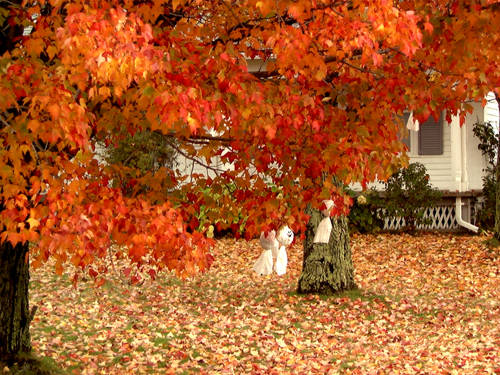|
"Oh
Sepantamaan! (1)
Lest you break your promises! It doesn' t matter if it is with a God Worshipper or an Evil Worshipper. A promise is a
promise and it must be honored and fulfilled." Thus spoke Ahuraa Mazdaa
(2)
with Zoroaster,(3) in Mehr Yasht.
(4)
Truth and valor are among the values honored by our pre-Zoroastrian ancestors
that later became the origin and the ultimate standards for heroism and bravery. It is said that Mehr has 1,000 ears and 10,000 eyes. The powerful
Mehr stays alert and never sleeps. Nothing can be kept hidden from Mehr.(5)
Mehr is worthy of worship and is a favorite of the warriors. Those who are
deceitful and lie, are the enemies of Mehr and in battle, their arrows would
be ineffective. Their horses won' t advance and won' t obey their riders.
Ultimately, they are defeated and victory is with those who support Mehr
with their good thoughts and brave deeds. There are other distinct accounts
for why Mehregaan is such an important festival.
Mehr is the seventh month in the Iranian calendar. It marks the start of
"The Great Winter" and is the name of the Guardian of Friendship, Love, and
Promise. It was in such a day that the sun appeared in the sky. Mehr is the
god/Guardian of light and illumination. It appears before the sunrise and
lasts after the sunset. Thus the distinction is made between Mehr and the
sun. However over time, people began to use these terms synonymously. It is
believed that sun was created during Mehregaan.
Mehregaan signals the beginning of Autumn Festival in October 2nd, which is
the Day of Mehr and continues for six consecutive days. The first five days
are public celebrations and the last day is reserved for a special family
feast. The last day is Raam Day and it means tranquility and peace. Pansy is
the flower and topaz is the color of Mehr. As you may know by now, each day
of the month has its own name and when the name of the Month and the name of
the Day were the same, a special festival was held. So it is with this tradition that in the month of Mehr and Day of Mehr, everyone took a break
from work and wore their clean and happy-color clothes. People in their
homes prepared special Mehregaan offerings similar to Haft-seen Tables that
are prepared for Norooz. Kings put on their glowing-sun crowns and sat on
their thrones. They met with people and gave gifts of clothing and gold to
them and listened to their complaints and rendered justice. Later, everyone
including the king, poured wine in their topaz color cups, and drank together, in honor of this auspicious day. According to Persian Mythology,
this is what Fereidoon did in Mehregaan, after imprisoning the evil king,
Zah-haak, in the Mountains of Damaavand. The full story of this significant
revolt led by Kaaveh Aahangar, a blacksmith who lost all but one of his sons
to the snakes that grew out of Zah-haak' s shoulders can be found in
Shaahnaameh. King Fereidoon' s ascendance to power meant the return of
justice and prosperity to Iran. Everyone celebrated and danced during this
period and it came to be known as a day of rest and relaxation. Mehregaan
was also a popular day to hold wedding ceremonies since it was all about love
and keeping commitments. Children who are born in this month have names
like, Mehraa, Mehri, Mehr-aaraa, Mehraan, Mehrabaan, Mehrzaad, Mehr-dokht,
Mehr-baanoo, Mehr-yaar, Meetraa, and so forth.
Mehregaan has a universal dimension to it as well. It is the time that earth
was created and expanded. It rivals Norooz as the second most important
Festival in Iran. By the first century A.D., People in Europe knew about
Mehregaan and had built special temples to honor this god of love, friendship
and commitments. Even the neighboring Arab countries observed the rituals and
referred to it as "Mehr-e-jaan."
There is an interesting story about the
first human being Keeyoumars (Geeya - Maretan) in the book of "Bondahesh"
which is a part of Zoroastrian literature. "Geeya" means life and "Maretan"
means mortal. Together they mean mortal beings or simply "people." Keeyoumars was the first human
Ahuraa Mazdaa created and after 30 years of solitude in the mountains, he
eventually died. Just before his death, his sperms were released from his loins and were purified by the rays of the sun
and were buried under ground. An amazing thing happens in Mehregaan when
after 40 years, from his sperms buried in the ground, two twisted stems of
rhubarb grew and later transformed into two human beings that were similar to
each other; one male (Masheeyeh) and the other a female (Masheeyaaneh). After passing of another fifty years, they got married and eventually their
subsequent offsprings became the various races of people that we have today. It was in Mehregaan that God added soul to human
body and thus, the Magic of Mehregaan became a gift of love and life to all human-kind. Merry Mehregaan
to all!
________________________________________________________________________
End Notes:
1 Sepantamaan: Holy & Pure. Zoroaster' s 9th ancestor
2 Ahuraa Mazdaa: The Great Life-giving, Wise One; (God)
3 Zoroaster: Bright and Shining Star, Name of the Iranian Prophet who lived
some 3739 years ago.
4 Mehr yasht: After Farvardeen Yasht, it' s the second longest poem dedicated
to Mehr.
5 Mehr: (Mitraa =Mitr) |

